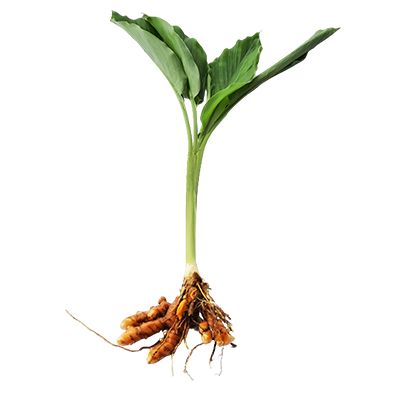Turmeric
Turmeric
Curcuma longa L.
Zingiberaceae Family
Description of Turmeric
Turmeric is a perennial herbaceous plant 60–100 cm tall. Rhizome branched, fleshy, bright orange inside, 2–5 cm in diameter, with thin lateral roots. Leaves basal, oblong-lanceolate, 20–50 cm long, bright green. Flowers yellow, gathered in spike-like inflorescences 10–15 cm long, surrounded by green or pinkish bracts. Fruits capsules, rarely used. Main raw material rhizome, dried and ground into powder. Flowering in July–August, rhizome harvest in October–December. Propagated by rhizome division. Varieties: ‘Alleppey’, ‘Madras’, ‘Erode’.
Distribution and Ecology of Turmeric
Turmeric originates from South Asia (India), cultivated in tropical and subtropical regions (India, China, Indonesia, Thailand, Vietnam). Prefers loose, well-drained soils (pH 5.5–6.5), partial shade or diffused light, high humidity. Optimal growth temperature 20–30 °C, does not tolerate frosts. Rhizome yield: 10–25 t/ha. Care: watering (15–20 L/m² every 5–7 days), feeding with organic fertilizers (20–30 kg/m²), protection from fungal diseases and root nematodes. Propagated by rhizome division (planting in March–April). Ecologically enriches soil with organic matter, but monocultures deplete the ground. Not invasive.
Raw Materials from Turmeric
Raw materials: rhizomes, powder, essential oil, rarely leaves. Rhizomes harvested in October–December, boiled or steamed, dried at 50–60 °C (yield 15–20%). Powder obtained by grinding dried rhizomes. Essential oil extracted by steam distillation from rhizomes (yield 1–5%). Leaves harvested in July–August, dried in shade (yield 10–15%). Quality: rhizomes orange-yellow, moisture <12%, curcumin ≥3%, organic/mineral impurities ≤0.5%, total ash ≤7%; oil yellow, clear; leaves green, no darkening. Store rhizomes and powder in airtight containers (2–3 years), oil in dark glass bottles (2 years). Rhizomes and powder aroma spicy, earthy; taste bitter-spicy.
Chemical Composition of Turmeric
Rhizomes: curcuminoids (3–7%, curcumin, demethoxycurcumin), essential oil (2–7%, turmerone, zingiberene), carbohydrates (60–70%), proteins (6–8%), vitamins (C, B6), minerals (potassium, magnesium, iron), phenolic compounds. Essential oil: turmerone (20–30%), zingiberene, cineole. Leaves: flavonoids, essential oil (0.1–0.2%). Calorie content of powder: 300–350 kcal/100 g.
Effects and Applications of Turmeric
Turmeric has powerful anti-inflammatory, antioxidant, antiseptic, choleretic, and hepatoprotective effects due to curcumin and essential oils. Rhizomes used for inflammations (arthritis, colitis), digestive disorders (flatulence, dysbacteriosis), liver support, cholesterol reduction, immunity strengthening. Essential oil used in aromatherapy for stress relief and inhalations for colds. Leaf infusions have mild anti-inflammatory effects, used for skin irritations. In cosmetology, turmeric lightens skin, reduces inflammations, improves complexion. Externally, powder and oil used for wound healing and acne treatment.
Precautions for Using Turmeric
Turmeric powder in large quantities (>5 g/day) or essential oil (>2 ml/day internally, undiluted externally) may cause stomach irritation, diarrhea, or allergic reactions. Prolonged use (more than 1 month) may affect gallbladder function. Store powder at humidity <12% to prevent mold. Give children under 3 years infusions in doses ≤5 ml/day. Do not combine with anticoagulants or liver drugs without doctor's consultation. Avoid oil on sensitive skin without dilution. Curcumin poorly absorbed without fats or black pepper.
Contraindications for Using Turmeric
Turmeric contraindicated in allergies to Zingiberaceae, exacerbation of peptic ulcer, cholelithiasis, acute pancreatitis, pregnancy, lactation, children under 1 year. External use of powder or oil prohibited in eczema, psoriasis, or open wounds.
Recipes with Turmeric
- Turmeric Tea for Colds. Pour 2 g turmeric powder with 200 ml boiling water, add 5 g honey and pinch of black pepper, drink 2 times a day, 7 days.
- Leaf Infusion for Dermatitis. Pour 10 g leaves with 200 ml boiling water, infuse 30 min, wipe skin 2 times a day, 7 days.
- Inhalation for Colds. Add 3 drops essential oil to 1 L hot water, breathe steam 10 min, 1 time a day, 5 days.
- Paste for Joints. Mix 5 g turmeric powder with 10 ml water, apply to joints for 20 min, rinse, use 1 time a day, 7 days.
- Infusion for Digestive Disorders. Pour 2 g turmeric powder with 200 ml boiling water, infuse 20 min, drink 50 ml 2 times a day, 10 days.
Cosmetics from Turmeric
Turmeric powder and essential oil used in cosmetology due to antiseptic, antioxidant, and anti-inflammatory properties, lighten skin, reduce acne.
- Face Mask. Mix 2 g turmeric powder with 10 g yogurt, apply to face for 10 min, rinse. Use 1 time a week.
- Body Scrub. Mix 5 g turmeric powder with 10 ml coconut oil, massage skin 5 min, rinse. Use 1 time a week.
- Skin Toner. Infuse 2 g turmeric powder in 200 ml boiling water 20 min, wipe face 1 time a day, 7 days.
- Hair Mask. Mix 3 ml turmeric essential oil with 20 ml olive oil, apply to hair roots, rinse after 20 min, 1 time a week.
Culinary Uses of Turmeric
Turmeric powder used as spice and natural dye in dishes (curry, soups, rice, drinks). Store powder at 0–5 °C in airtight container up to 3 years. Varieties: ‘Alleppey’ (for color), ‘Madras’ (for flavor).
- Rice with Turmeric. Add 2 g turmeric powder to 200 g cooked rice with 10 ml olive oil, serve warm.
- Golden Milk. Mix 2 g turmeric powder with 200 ml milk, 5 g honey, pinch black pepper, heat to 70 °C, drink warm.
- Curry Sauce. Mix 3 g turmeric powder with 100 ml coconut milk, 5 g ginger, 5 g garlic, serve with meat.
- Turmeric Tea. Pour 2 g turmeric powder with 200 ml boiling water, add 5 g honey, infuse 10 min, serve warm.
Other Properties of Turmeric
Turmeric used in pharmaceuticals (anti-inflammatory drugs), dyes (food industry), perfumery. Plant ornamental for tropical gardens. Essential oil used as insect repellent. Turmeric used in Ayurveda and aromatherapy.




